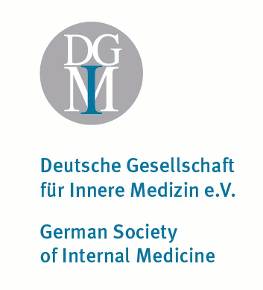Moscow - Historical Center of Russia
Kremlin
The Kremlin at the center of Moscow is an outstanding historical and architectural monument that serves as a symbol for the whole Russia.
In Old Russia the word "kreml" meant the central, fortified part of a city. The Moscow Kremlin that originally was made of wood was mentioned in the chronicles in 1156 as "Moscow fortress". At that time it occupied only the south-western part of the Borovitsky Hill. In 1326-1327 on the highest point of the hill the Assumption Cathedral, the first stone cathedral in the Kremlin, was constructed. And in 1366-1368, during the reign of Prince Dmitry Donskoy, the first stone Kremlin was put up.

As Moscow and Moscow Principality were getting more and more important, the significance of the Kremlin was also growing. The ordinary fortified city center was turning into the residence of Great Prince of Moscow and metropolitan.
At the time of Ivan III, who was the first one to be called the Prince of Whole Russia, the Kremlin was constructed in stone. Ivan III invited not only Russian, but also Italian architects to participate in the Kremlin creation. In 1475-1479 the new Assumption Cathedral was designed by Italian architect Aristotel Fioravanti. In front of the Assumption Cathedral another Italian architect Aloisio Novy put up the Cathedral of Saint Mikhail the Archangel (Archangelsky Cathedral). In the western side of Sobornaya Square the palace of Ivan III was built. It included several chambers, but until nowadays only the Granovitaya Chamber survived. This chamber, designed by Marco Fryazin and Pietro Antonio Solari in 1487-1491, served as a gala throne hall of Ivan III.
In 1485-1495 Italian masters put up the new, notched walls and towers of the Kremlin. In 1505-1508 architect Bon Fryazin constructed the Bell-Tower of Ivan the Great, so the ensemble of Sobornaya Square was complete. The square served as a place for important ceremonies and devotions.
In 1547 Great Prince Ivan IV the Terrible officially accepted the title of tsar. Since then the Kremlin turned into the residence of Russian tsars. To commemorate the conquest of Kazan khanate by Ivan the Terrible in 1555-1561 the Cathedral of Protection of the Virgin was erected. Today it is more known as St. Basil Cathedral. It was built outside the Kremlin walls, close to Spasskie Gates where another important center of Moscow, Red Square, formed. The Polish intervention of 1605-1612 damaged the architectural complex of the Kremlin. The cathedrals were looted and desecrated, tsars' treasury suffered greatly, and all the wooden constructions were demolished and burnt. When the Romanov family got the power, the Kremlin was restored. It reached its golden age by the end of the 17th century. The distinctive beauty of the Kremlin ensemble made the contemporaries compare it with "the city of Jerusalem".

The 18th century started for the Kremlin with a terrible fire. On the site of burned constructions Peter I ordered to put up the Arsenal. Construction works were finished by 1736 at the time of Empress Anna Ioannovna. In front of the Arsenal the Tsar Cannon was installed. It was cast in 1586 by master Andrey Chokhov. The caliber of the Tsar Cannon is the largest in the world. In 1735 cast-iron gun-carriage and balls were made for the cannon. Nowadays the Tsar Cannon is placed on the pedestal close to the Church of Twelve Apostles.
Another sight of the Kremlin is the Tsar Bell cast in 1733-1735 by Russian masters Matorins by order of Anna Ioannovna.
During the fire of 1737 the Tsar Bell cracked, and a piece of it broke off. Until 1836 the bell was in the founding pit, and then it was placed on the pedestal designed by architect Montferrand. Nowadays the Tsar Bell is installed near the Bell-Tower of Ivan the Great.
In 1810 the Armory Museum was built in the Kremlin. Construction works were supervised by architect A. Egotov. The facade of the museum was decorated with bas-relieves depicting scenes from Russian history. As for the attic, it was topped with statues of outstanding Russian enlighteners. The war of 1812 broke out, so the museum was not opened. Moscow captured by French troops was looted and burnt, and the Kremlin was badly damaged. After the end of the war the blown-up walls and towers of the Kremlin, the Arsenal, the Assumption belfry and Filaretova annex of Bell-Tower of Ivan the Great were carefully restored. In 1814 the Arsenal was opened for the visitors.
In 1838-1851 Emperor Nicolas I ordered to put up the new palace complex in traditional Russian style on the territory of the Kremlin. The complex consisted of the Great Kremlin Palace, constructed on the site of the Winter Palace, the building of Apartaments and the new Arsenal building that was more solemn than the previous one. Architect K. Ton was appointed to supervise the construction works. The new buildings completed the ensemble of Palace or Imperial Square.
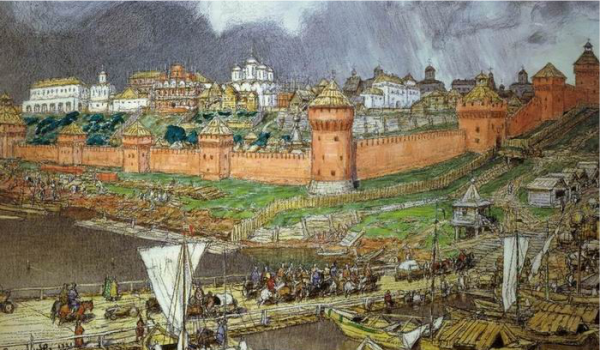
At the end of the 19th-the beginning of the 20th century the Kremlin was already taken by contemporaries as the monument of Russian history and culture. There was an idea to turn the Kremlin complex into the giant museum, but the October Revolution of 1917 interfered with the plans.
In March, 1918 the first Soviet Government moved to Moscow and settled down in the Kremlin. The Kremlin was closed for visitors. In 1929 the old monasteries on the Kremlin territory were pulled down. Instead of them the Military School was put up. In 1935 the double-headed eagles were taken away from the Kremlin Towers. In 1937 the five towers of the Kremlin were decorated with ruby stars of 3-3,75 meters in size.
Since 1955 the Kremlin was opened for the public. In 1961 on the site of the first Armory, at the Troitskie Gates the State Kremlin Palace was put up. It was the last significant construction on the territory of the Kremlin. In 1970-1980s the unique restoration works took place in the Kremlin. And in 1990 it was included in the World Cultural Heritage List of UNESCO.
In 1991 the State Historical and Cultural Museum-Preserve Moscow Kremlin was founded. It consists of the Armory, Assumption Cathedral, Archangelsky Cathedral, Annunciation Cathedral, the Church of the Deposition of the Holy Robe, the Museum of Applied Art and Russian Everyday Life of the 17th century, and the architectural ensemble of the Bell-Tower of Ivan the Great.
Red Square
Red Square is a large open square in the center of Moscow. It is located in front of the Kremlin's western wall. The square is fenced in the State Historical Museum building, the GUM building, and St. Basil Cathedral. For many centuries Red Square has served as the place for important historical events.
Red Square was founded at the end of the 15th century when Ivan III ordered to demolish wooden constructions around the Kremlin walls to prevent the tsar's residence from a fire. On the site of wooden constructions by the Kremlin's western wall a trade square started to form.
Originally, it was called Torgovaya Square (Trade Square), then it got the name of Trinity Square, as the Trinity Church was located in the southern side of the square. The square obtained its modern name in the 17th century.
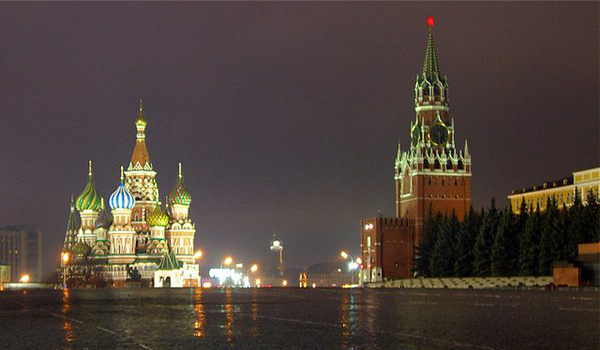
In an effort to fortify the Kremlin the 12-meters ditch was dug in 1508-1516. It connected Moscow River and Neglinnaya River. The ditch fenced in walls was filled up only after 1812. In the northern side of the square the Kitai-Gorod gates were located, and the western side featured trade rows. In 1555-1560 on the side of the Trinity Church the Pokrovsky Cathedral (St. Basil Cathedral) was put up by Russian architects Barma and Postnik.
In the 30s of the 16th century a dais was constructed on Red Square. It was called the Lobnoe Mesto (place of execution). It served as a rostrum for annunciation of important events such as government communique and solemn ceremonies. Sometimes it was used for executions. The Lobnoe Mesto got its modern shape in 1786 when it was rebuilt by architect M. Kazakov. The Lobnoe Mesto looks like a round stone eminence edged with a parapet and stairs.
By the end of the 17th century Red Square grew in importance for Moscow and the whole country. In 1697 the Mint was put up on the square, in 1699 the Zemsky Department was constructed, and later the Main Drugstore was erected. In 1755 Moscow University started to function in the building of the drugstore.
In 1786 the new trade rows designed by architect Quarenghi were put up in front of the Kremlin wall. The building was destroyed during the Patriotic War of 1812, and in 1814-1815 it was rebuilt. In 1818 in front of the building the monument to heroes of struggle against Polish intervention Kozma Minin and Prince Dmitry Pojarsky was put up. In 1930 the monument made after sculptor I. Martos's design was moved to the Pokrovsky Cathedral.
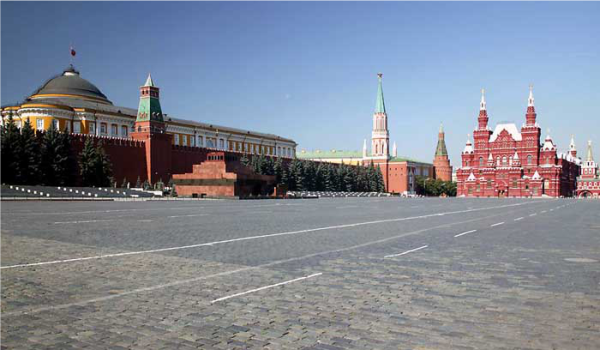
At the end of the 19th century the look of Red Square changed noticeably. In 1875-1881 on the site of Zemsky Department the Historical Museum was put up. It was designed by architect V. Sherwood. In 1889-1893 the building of the Upper trade rows that nowadays houses the GUM department store was put up to A. Pomerantsev's design. These buildings were constructed in pseudo-Russian style to match the walls and towers of the Kremlin.
The next stage of Red Square ensemble formation was closely connected to the Soviet period of Russian history. Red Square together with the Kremlin turned into the symbol of the new power, and its name was associated with Revolution. Since 1918 Red Square served as a place for parades and demonstrations. On Red Square the parade of the 7th of November, 1941 took place, the participants of which were leaving for the front. The parade dedicated to the victory in World War II also took place on Red Sqaure on the 24th of June, 1945.
In 1924 the wooden Mausoleum designed by architect A. Shchusev was put up on Red Square. It became the burial place of Vladimir Lenin. In 1929-1930 the Mausoleum was rebuilt in stone, and in 1930-1931 the rostrums above the Mausoleum were constructed after architect V. Frantsuz's design. Along the Kremlin walls the fir-trees were planted, and Red Square that used to be cobbled was covered with cubes.
St. Basil Cathedral
St. Basil Cathedral is one of the most outstanding and remarkable monuments of Old Russian architecture. In the 16th century the tourists admired the beauty of the cathedral, and for the Russians it became the symbol of native history and culture.

In 1552 the temple consecrated in honor of Saint Trinity was put up. The temple was to commemorate the victory of Ivan the Terrible over Kazan and Astrakhan khanate. In 1554 Tsar ordered to construct the Cathedral of the Intersection of the Blessed Virgin on the site of the temple. The chapels of the cathedral were commemorating the victory over the Tatars. Later Saint Basil, Moscow "God's fool" was buried in one of the chapels, hence the name of the cathedral.
According to chronicles, St. Basil Cathedral was designed by Russian architects Postnik and Barma. There is the legend saying that Ivan the Terrible admired the beauty of the cathedral and ordered to blind the architects so they could never construct such a masterpiece again. Some historians insist that the cathedral was designed by one person - Ivan Barma who had a nickname Postnik as he kept the fast. The legend of the architects' blindness could be refuted by the fact that the name of Postnik was the author of many architectural monuments mentioned in the chronicles after St. Basil Cathedral construction.
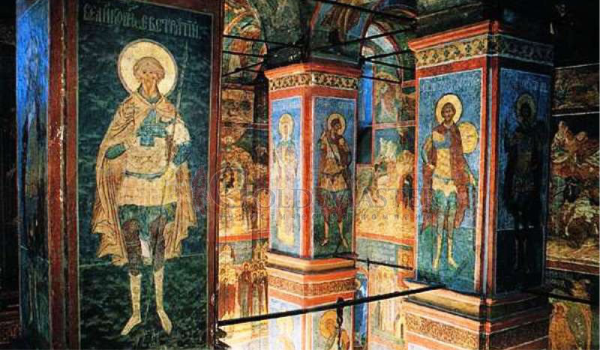
St. Basil Cathedral is a symmetrical architectural ensemble consisting of eight chapels surrounding the ninth temple, which is the highest one. It is topped with a hipped roof. Each chapel bears the name of a saint. The central temple is dedicated to the Intersection of the Blessed Virgin. The chapels are conjoined by the system of passages. The cupolas that top the chapels are different from each other. Each cupola is decorated with windows, niches, and cornices. The cathedral impress as a festive and elegant one. Until the end of the 17th century when the Ivan the Great Bell-Tower was constructed on the Kremlin territory, St. Basil Cathedral was the highest construction in Moscow. The cathedral is 60 meters high.
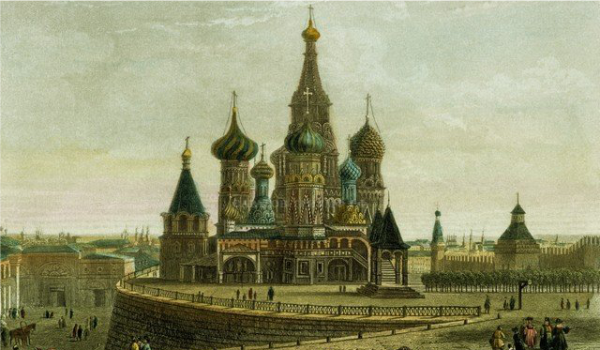
In St. Basil Cathedral there are 9 icon-stands containing about 400 icons of the 16th-19th centuries. The icons are great examples of Moscow and Novgorod schools of icon painting. The walls of the cathedral are decorated with oil paintings and frescoes of the 16th-19th centuries. In the cathedral one can see portrait and landscape painting of the 19th century, and church plate of the 16th-19th centuries. Among the most precious items is the chalice of the 17th century that used to belong to Tsar Aleksey Mikhailovich.
In the middle of the 20s of the 20th century St. Basil Cathedral got the status of museum. Since 1934 it is the branch of the State Historical Museum in Moscow.
Novodevichy Convent
The Novodevichy Convent is located in the south-west of Moscow, at the curve of Moscow-River. The Novodevichy Convent ensemble is an outstanding monument of architecture of the 16th-17th centuries.

The most attractive construction of the Novodevichy Convent ensemble is the Smolensky Cathedral, or the Cathedral of Our Lady of Smolensk Icon. It was built at the same time when the convent was founded. The monumental five-domed cathedral features the paintings of the 16th-17th centuries, rare icons of the 17th century, and a five-tiered carved icon-stand. The Refectory with the Assumption Church, the belfries, Mariinskie and Lopukhinskie chambers are perfect examples of Moscow Baroque style.
The convent was founded by Vasily III in 1524 to commemorate the fact that Smolensk was returned as a part of Russia. Hence the second name of the convent - Bogoroditse-Smolensky.
In the 16th-17th centuries the convent became the place where the women of the Tsar family took the veil. In the convent the widow of the elder son of Ivan the Terrible lived. After death of Tsar Fyodor Ioannovitch his widow Irina Godunova chose the Novodevichy Convent as a place of dwelling. Her brother, future tsar Boris Godunov, stayed with her for some time. The sister of Peter the Great, tsarevna Sofia, spent her last days in the Novodevichy Convent. She was forced to take the veil, as well as the first wife of Peter the Great, Evdokia Lopukhina was.
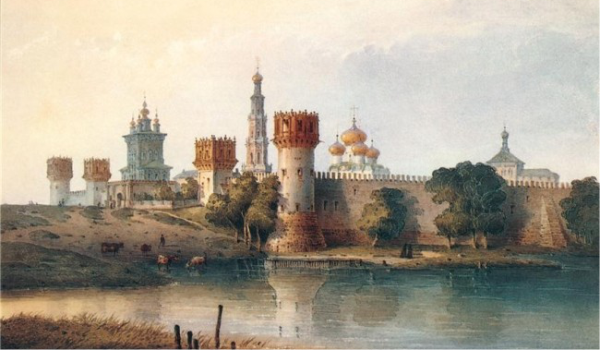
The Novodevichy Convent was always under the patronage of Russian rulers and possessed vast chapter-lands. The nuns living in the convent were the representatives of higher classes and nobility. In 1724 part of the convent was given to the hospital for solders and officers of Russian army, and orphanage for girls-foundlings.
During the war of 1812 the Novodevichy Convent was occupied by French troops. When they were forced to retreat, they wanted to blow the convent up. However, the nuns managed to put the fuses out and save the Novodevichy convent.
Since the end of the 18th century till 1868 the Novodevichy Convent was used as a reformatory for Moscow and Moscow region women condemned for impiety.
At the beginning of the 20th century the fate of the Novodevichy Convent changed dramatically. In 1922 the convent was closed and turned into museum that later became the part of the State Historical Museum. Since 1980 the Novodevichy Convent houses the residence of Krutitsky and Kolomensky metropolitan. In 1994 the convent was re-established. Since 1995 religious services take place in the Smolensky Cathedral on high days.

In the 16th century on the territory of the Novodevichy Convent the cemetery intended for church and secular elite representatives was established. In the 19th century the heroes of the war of 1812 were buried in the cemetery. Among them was the poet and hussar Denis Davidov, decembrists S. Trubetskoi and M. Muraviev-Apostol, famous cultural workers, including historian S. Soloviev and philosopher V. Soloviev.
The Novodevichy Convent is included in the UNESCO World Heritage List. It ranges among the oldest and the most beautiful convents in Russia.
On August 10, 2004 the Novodevichy Convent celebrated its 480th birthday.
Arbat
The Arbat located between Arbatskie Vorota Square and Smolenskaya Square is one of the most famous streets in Moscow. The Arbat is also one of the symbols of old Moscow, which was celebrated in poems, novels, songs and movies. Nowadays the Arbat is the name of the pedestrian street, but actually the Arbat is the whole district of Moscow that marked its 500th birthday in 1993.
The Arbat Street ranges among the oldest in the Russian capital. Its exotic name comes from an Arabian word "arbad" ("rabad") that means "suburb, estate". This word was probably brought to Moscow by Crimean Tatars or Arabian merchants in the 15th century. In the middle of the 17th century there were attempts to rename the street Smolenskaya, but this name did not find acceptance.

Originally, the Arbat was the place where merchants and craftspeople lived, but by the end of the 18th century they were replaced by the noblemen. In the middle of the 19th century the Arbat turned into the prestigious and fashionable place. The richest and the most powerful Russian families preferred to have their mansions here. The Arbat was a peaceful and quiet district where the relatively small mansions in the Empire style and wooden houses surrounded by gardens were put up. The Arbat did not feature large shops. The area was popular among the doctors, lawyers, writers and poets. In different times, the Arbat was the place of stay for Alexander Pushkin, Sergey Rakhmaninov, Alexander Skryabin, Nikolay Gogol, Lev Tolstoy, Mikhail Saltikov-Shchedrin, Anton Chekhov, and Alexander Block. Life of famous director Evgeniy Vakhtangov and his theater was closely connected to the Arbat.
By the end of the 19th century the Arbat started to approach its modern look. A lot of shops and many-storied tenement-houses were constructed.
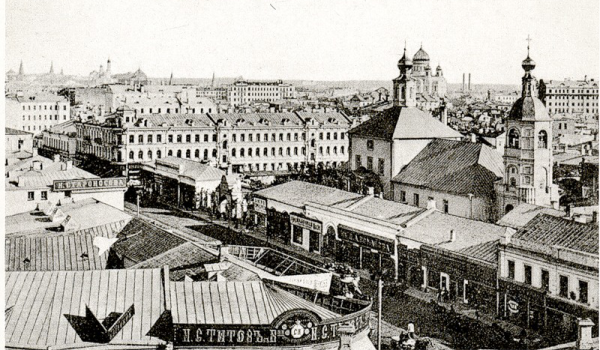
At the time of the Soviet power the look of the Old Arbat underwent irreversible changes. At the beginning of the 1960s the side streets of the Arbat were turned into the part of Kalinina Prospect that was lately renamed the New Arbat. It resulted in destruction of many architectural monuments of the 18th-19th centuries. The Muscovites neatly called the new street "the dentures".
In 1974-1986 the Arbat became the pedestrian street with plenty of small shops, cafes and lively pedlary. It is the place where artists work, street singers perform, and Russian souvenirs are sold. The Old Arbat is a very popular place, especially among the tourists, since the Muscovites are pretty skeptical about such a transformation of the famous Moscow corner.
The Arbat feature memorial museums dedicated to Alexander Pushkin, Marina Tsvetaeva, and Mikhail Lermontov. The street also features a number of old mansions decorated with moldings, balconies, and caryatids. In the Arbat, 2 there is the famous Prague Restaurant that exists since 1872.
Metro
For the first time the idea of constructing the underground railroad in Moscow appeared at the beginning of the 20th century, when the city population exceeded one million. The project of metro construction presented in 1902 to Moscow Duma implied that some metro lines would pass overland, and the trains would run by the tunnels and platforms from the Central Railway Station that was supposed to be nearby the Red Square. The project was remarkable for fresh engineering ideas, but Moscow Duma rejected it, since the owners of tram company indignantly opposed the project.
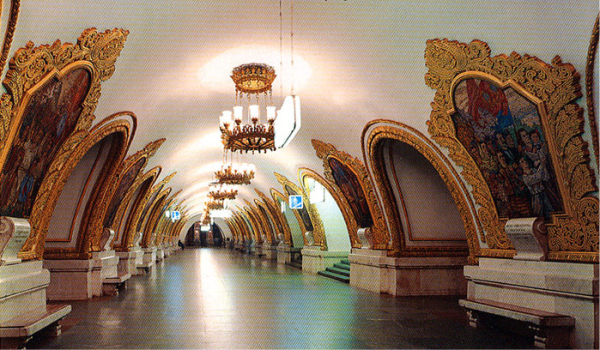
At the time of Soviet power the idea of metro construction reappeared. The first, experiment tunnel was built in 1931, and in 1932 the construction works started. It took 21 percent of Moscow budget to keep the works going. The plans were grandiose, but there was not enough hardware, so propaganda and people's enthusiasm were the only things that could help. Young people from all over the Soviet Union were invited to participate in metro construction. Miners of Donbass, concrete makers of Dneprostroy, and Moscow members of Komsomol took part in metro building. The history of metro construction is reflected in the movie "The volunteers".
The first line of Moscow metro was opened on May 15, 1935, at 7 a.m. Some Muscovites were waiting for metro opening all night long, as they wanted to be the first ones to try the novelty.
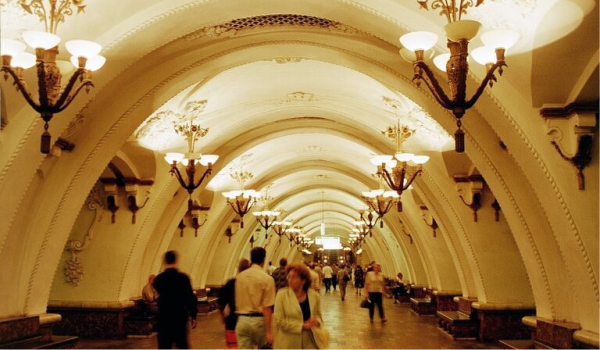
Some stations were designed by outstanding Soviet architects. Among them was A. Shchusev, the author of the Mausoleum in Moscow. The grand stations looked like palaces. They were decorated with stained-glass windows, paintings, majolica, and even sculptural groups. Stations were faced with marble, granite, and other various stones.
Soon after the opening, the metro became the inseparable part of Moscow. During World War II, the stations of the metro served as air-raid shelters to hundreds of thousands of Muscovites. Some stations housed military and state institutes. For example, the Kirovskaya station housed the departments of the Red Army General Staff. Trains did not stop there, and the platform was separated from the railroad by high plywood partition. Even in the days of the war the construction works did not stop.

After the end of the war new stations were less magnificent, since ferroconcrete items and cheaper materials were used. Unfortunately, striving for economy made some stations look ordinary. Only in the 1970-1980s the idea of decorating each station in unique way reappeared.
Nowadays Moscow metro takes the first place in functioning capacity in the world. The general length of the metro is over 265 kilometers, and since early morning till late night 170 stations function.
Moscow metro grows together with the city. By 2010 the city administration plans to put into operation over 80 kilometers of new lines that would connect the center of the city with its furthest outskirts.
All-Russian Exhibition Center
Russian abbreviation VDNH means "Exhibition of National Economy Achievements". Recently it was renamed the All-Russian Exhibition Center. It is a very large complex containing exhibition halls, rest area, and a giant trade center. The center is a "must" for Moscow guests. As for Muscovites, they enjoy spending their time there.
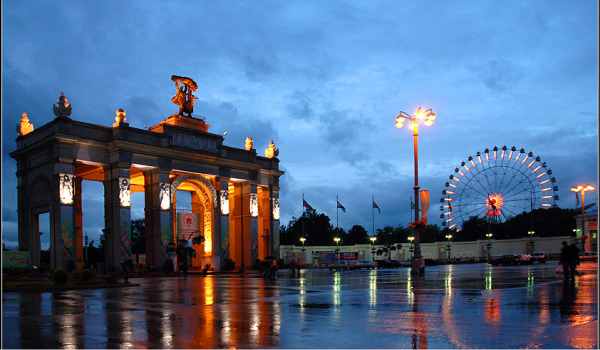
The unique ensemble of the exhibition area had been forming for several decades. The first All-Union Agricultural Exhibition was opened in Ostankino on the 1st of August, 1939. The exhibition occupied 136 hectares and looked like a town with a large park, ponds, numerous pavilions and agricultural constructions. It included 250 large and small buildings. The wide alley was conjoining the main entrance and the main pavilion. Close to it there was a 52-meters tower with a 13-meters statue depicting the tractor operator and collective farmer holding the wheat sheaf above their heads. The sculpture became the symbol of the exhibition. The exhibition was a very successful one. From the 1st of August till the 25th of October, 1939 over 3,5 million people visited it.
From 1941 till 1954 the exhibition was closed, and in 1954 it was reconstructed. The territory of the exhibition complex was enlarged, the number of buildings increased to 383, and the new entrance on the territory on the complex was conveniently conjoined with the metro station. The new octagonal square near the main pavilion completed the exhibition complex ensemble. The new square was connected with Mechanization Square by two fountains - "The People's Friendship" and "The Stone Flower". The pavilions that were put up in those times were notable for their pomposity.

The All-Union Exhibition of National Economy Achievements that took place in 1958 combined the All-Union Agricultural Exhibition, the Industrial Exhibition, and Construction Exhibition.
In 1960s-1980s the exhibition complex was considered to be unique and grandiose. It presented all the scientific and industrial achievements of the USSR. It was impossible to see all the exhibitions and fairs during one day. The total length of all the VDNH alleys equaled 65 kilometers, and visitors had to take special excursion buses to travel around the exhibition complex. In summer the exhibition territory was turning into the giant garden with various attractions, the dancing verandah, the Green Theater, and two summer cinema halls. In winters the guests were entertained by horse riding. Near the Northern entrance the famous sculpture "Worker and Female Collective Farmer" by V. Mukhina was placed. The sculpture was made in Paris in 1937.
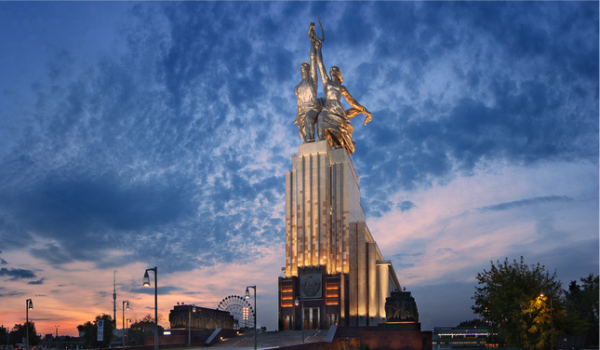
In 1989 the exhibition hall got the status of All-Union, and since 1992 it is called the All-Russian Exhibition Center. Nowadays it successfully combines commercial and educational goals. Some pavilions are rented by trade companies.
The All-Russian Exhibition Center is the most popular exhibition and fair complex of the country presenting the economical, scientific, and cultural achievements of Russia and the Commonwealth of Independent States.
Bolshoi Theatre
The Bolshoi Theatre is a historic theatre in Moscow, Russia, designed by the architect Joseph Bové, which holds performances of ballet and opera. The Bolshoi Ballet and Bolshoi Opera are amongst the oldest and greatest ballet and opera companies of the world, respectively. The theatre is the parent company of The Bolshoi Ballet Academy, a world-leading school of ballet.
The company was founded in 1776 by Prince Peter Urusov and Michael Maddox. Initially, it held performances in a private home, but in 1780, it acquired the Petrovka Theatre and began producing plays and operas.
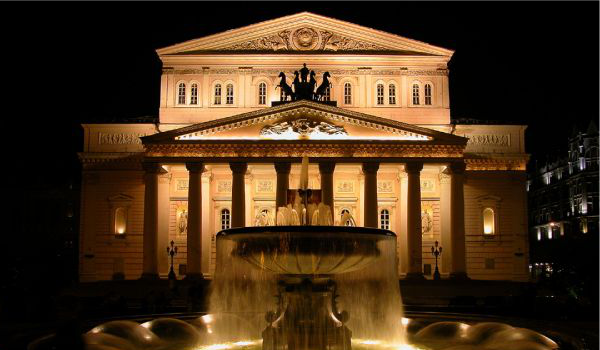
Auditorium of the Bolshoi Theatre. The current building was built on Theatre Square in 1824 to replace the Petrovka Theatre, which had been destroyed by fire in 1805. It was designed by architect Andrei Mikhailov, who had built the nearby Maly Theatre in 1824.
At that time, all Russian theatres were imperial property. Moscow and St Petersburg each had only two theatres, one intended for opera and ballet (these were known as the Bolshoi Theatres), and one for plays (tragedies and comedies). As opera and ballet were considered nobler than drama, the opera houses were named "Grand Theatres" ("Bolshoi" being the Russian for "large" or "grand") and the drama theatres were called "Smaller Theatre" ("Maly" being the Russian for "small", "lesser", or "little").
The Bolshoi Theatre's original name was the Imperial Bolshoi Theatre of Moscow, while the St. Petersburg Bolshoi Theatre (demolished in 1886), was called the Imperial Bolshoi Kamenny Theatre.
The Moscow theatre was inaugurated on 18 January 1825 with a performance of Fernando Sor's ballet, Cendrillon. Initially, it presented only Russian works, but foreign composers entered the repertoire starting around 1840. A fire in 1853 caused extensive damage; reconstruction was carried out by Alberto Cavos, son of Catterino Cavos, an opera composer. The theater reopened in 1856. During World War II, the theatre was damaged by a bomb, but it was promptly repaired.
The Bolshoi has been the site of many historic premieres including Tchaikovsky's The Voyevoda and Mazeppa, and Rachmaninoff's Aleko and Francesca da Rimini.
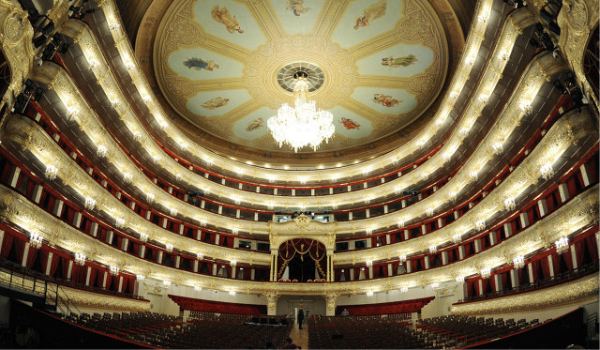
Ballet and opera. The Bolshoi is a repertory theatre, meaning that it draws from a stable of productions, any one of which may be performed on a given evening. It normally introduces two to four new ballet or opera productions each. season and retires a similar number. The sets and costumes for most productions are made in the Bolshoi's own workshops. The performers are drawn primarily from the Bolshoi's regular ballet and opera companies, with occasional guest performances. Since the collapse of the Soviet Union, there have been a few attempts to reduce the theatre's traditional dependence on large state subsidies. Corporate sponsorship occurs for some productions, but state subsidy is still the lifeblood of the company.
The Bolshoi has been associated from its beginnings with ballet. Tchaikovsky's ballet Swan Lake premiered at the theatre on Saturday, March 4, 1877. Other staples of the Bolshoi repertoire include Tchaikovsky's The Sleeping Beauty and The Nutcracker, Adam's Giselle, Prokofiev's Romeo and Juliet, and Khachaturian's Spartacus. After the death of Stalin, international touring companies from the Bolshoi became an important source of cultural prestige, as well as foreign currency earnings, and as a result the "Bolshoi Ballet" became a well-known name in the West. However, the Bolshoi suffered from losses through series of defection of its dancers. The first occurrence[1] was on August 23, 1979, with Alexander Godunov; followed by Leonid Kozlov and Valentina Kozlova on September 16, 1979; and other cases in the following years. Bolshoi-related troupes continue to tour regularly in the post-Soviet era.
The opera company specializes in the classics of Russian opera such as Mussorgsky's Boris Godunov, Glinka's A Life for the Tsar, and Rimsky-Korsakov's The Tsar's Bride, as well as the operas of Tchaikovsky. Many operas by western composers are also performed, especially works of Italian composers such as Rossini, Verdi, and Puccini. Until the mid-1990s, most foreign operas were sung in Russian, but Italian and other languages have been heard more frequently on the Bolshoi stage in recent years.
Some operas, such as Borodin's Prince Igor, include extensive ballet sequences. Many productions, especially of classic Russian opera, are given on a scale of grand spectacle, and can have dozens of costumed singers and dancers on stage for crowd or festival scenes.

Current status of the Bolshoi. Bolshoi Theatre’s reconstruction. August 2007. The main Bolshoi Theatre closed for restoration in 2005, and, as of late 2009, is scheduled to reopen in October 2013. The Theatre has undergone many renovations in its lifetime, but none as major as this. The restoration will cost $US730 million (The restoration was initially due to cost 15 billion roubles ($610 million) but engineers found the structure was more than 75 percent unstable), and is funded entirely by the federal government.
The restoration will repair the foundation and brickwork. The renovation is intended to restore the original acoustics of the theatre, which were largely lost as a result of renovations during the Soviet era. Inside the theatre, the entire space has been stripped from the bottom up, the 19th-century wooden fixtures, silver stage curtain and French-made red velvet banquettes removed for repair in specialist workshops. At the very top of the facade, the two-headed eagle of the original Russian coat of arms has been installed in place where the Soviet hammer and sickle hung for decades.
The New Bolshoi Theatre, adjacent to the original and built incredibly in only six months, continues to stage an extensive repertory of concerts and performances. Since these two theatres are the most famous in Moscow, they are usually frequented by tourists, and the prices can be correspondingly much more expensive when compared to other Russian theatres, particularly for ballets, where the prices are comparable to those for performances in the West.










.jpg)
